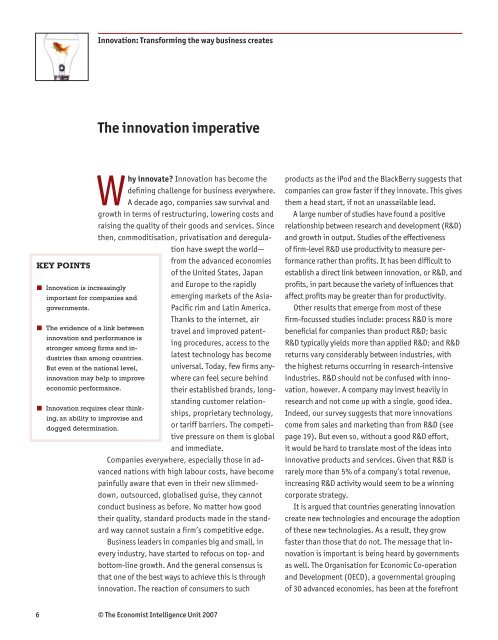Innovation: Transforming the way business creates
Innovation: Transforming the way business creates
Innovation: Transforming the way business creates
Create successful ePaper yourself
Turn your PDF publications into a flip-book with our unique Google optimized e-Paper software.
<strong>Innovation</strong>: <strong>Transforming</strong> <strong>the</strong> <strong>way</strong> <strong>business</strong> <strong>creates</strong>The innovation imperativeWhy innovate? <strong>Innovation</strong> has become <strong>the</strong>defining challenge for <strong>business</strong> everywhere.A decade ago, companies saw survival andgrowth in terms of restructuring, lowering costs andraising <strong>the</strong> quality of <strong>the</strong>ir goods and services. Since<strong>the</strong>n, commoditisation, privatisation and deregulationhave swept <strong>the</strong> world—from <strong>the</strong> advanced economiesKEY POINTSof <strong>the</strong> United States, Japann <strong>Innovation</strong> is increasinglyand Europe to <strong>the</strong> rapidlyimportant for companies and emerging markets of <strong>the</strong> Asiagovernments.Pacific rim and Latin America.Thanks to <strong>the</strong> internet, airn The evidence of a link betweentravel and improved patentingprocedures, access to <strong>the</strong>innovation and performance isstronger among firms and industriesthan among countries. latest technology has becomeBut even at <strong>the</strong> national level, universal. Today, few firms anywherecan feel secure behindinnovation may help to improveeconomic performance.<strong>the</strong>ir established brands, longstandingcustomer relationships,proprietary technology,n <strong>Innovation</strong> requires clear thinking,an ability to improvise anddogged determination.or tariff barriers. The competitivepressure on <strong>the</strong>m is globaland immediate.Companies everywhere, especially those in advancednations with high labour costs, have becomepainfully aware that even in <strong>the</strong>ir new slimmeddown,outsourced, globalised guise, <strong>the</strong>y cannotconduct <strong>business</strong> as before. No matter how good<strong>the</strong>ir quality, standard products made in <strong>the</strong> standard<strong>way</strong> cannot sustain a firm’s competitive edge.Business leaders in companies big and small, inevery industry, have started to refocus on top- andbottom-line growth. And <strong>the</strong> general consensus isthat one of <strong>the</strong> best <strong>way</strong>s to achieve this is throughinnovation. The reaction of consumers to suchproducts as <strong>the</strong> iPod and <strong>the</strong> BlackBerry suggests thatcompanies can grow faster if <strong>the</strong>y innovate. This gives<strong>the</strong>m a head start, if not an unassailable lead.A large number of studies have found a positiverelationship between research and development (R&D)and growth in output. Studies of <strong>the</strong> effectivenessof firm-level R&D use productivity to measure performancera<strong>the</strong>r than profits. It has been difficult toestablish a direct link between innovation, or R&D, andprofits, in part because <strong>the</strong> variety of influences thataffect profits may be greater than for productivity.O<strong>the</strong>r results that emerge from most of <strong>the</strong>sefirm-focussed studies include: process R&D is morebeneficial for companies than product R&D; basicR&D typically yields more than applied R&D; and R&Dreturns vary considerably between industries, with<strong>the</strong> highest returns occurring in research-intensiveindustries. R&D should not be confused with innovation,however. A company may invest heavily inresearch and not come up with a single, good idea.Indeed, our survey suggests that more innovationscome from sales and marketing than from R&D (seepage 19). But even so, without a good R&D effort,it would be hard to translate most of <strong>the</strong> ideas intoinnovative products and services. Given that R&D israrely more than 5% of a company’s total revenue,increasing R&D activity would seem to be a winningcorporate strategy.It is argued that countries generating innovationcreate new technologies and encourage <strong>the</strong> adoptionof <strong>the</strong>se new technologies. As a result, <strong>the</strong>y growfaster than those that do not. The message that innovationis important is being heard by governmentsas well. The Organisation for Economic Co-operationand Development (OECD), a governmental groupingof 30 advanced economies, has been at <strong>the</strong> forefront © The Economist Intelligence Unit 2007
















